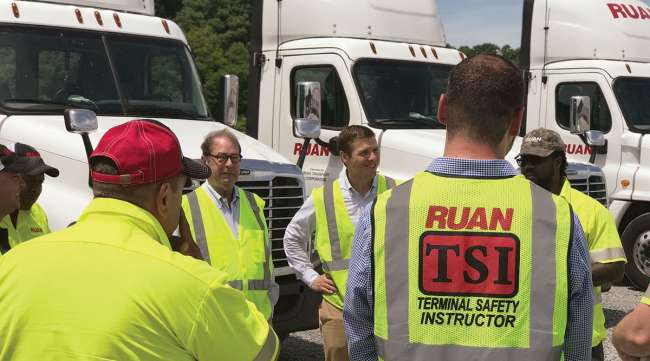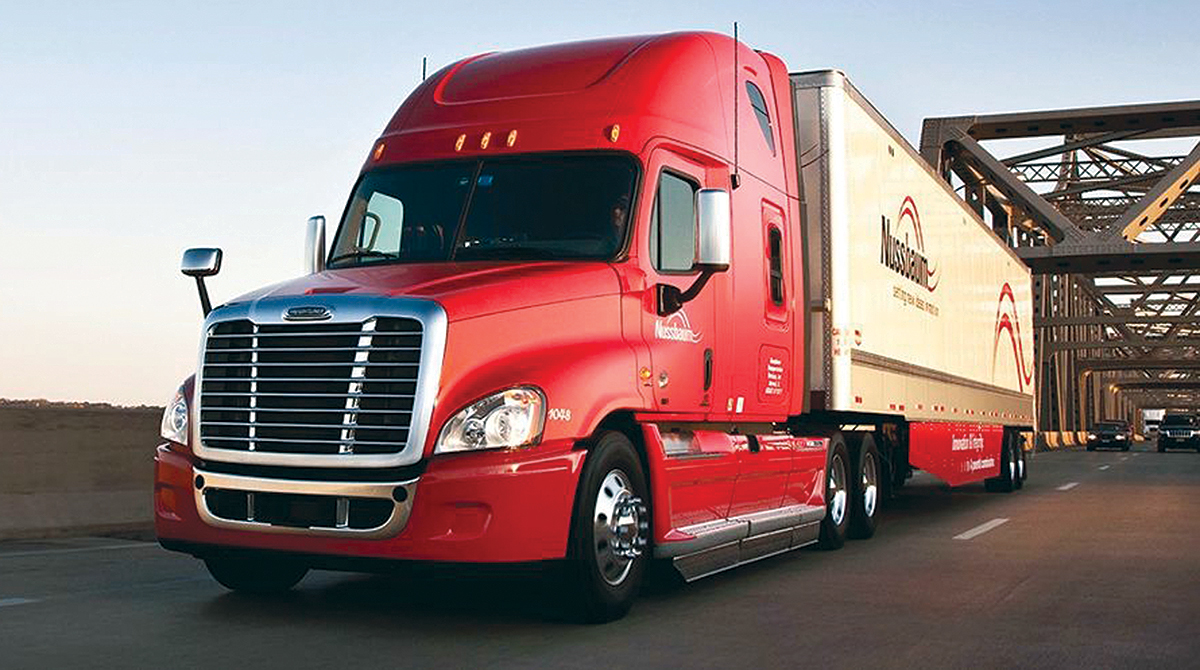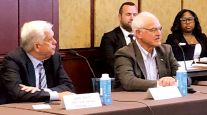Fleets Transitioning to New Management as Industry Prepares for the Road Ahead

As the trucking industry enters a time of change driven by the advance of technology, increasing freight demand and rising customer expectations, fleets increasingly are turning to a new generation of leaders to adapt to these challenges and lead the industry forward.
This year in particular has brought a changing of the guard at some of the nation’s largest trucking companies.
In April, Schneider tapped Mark Rourke to become only the fourth president and CEO to lead the 84-year-old business. Meanwhile, CRST International brought in an outsider, Hugh Ekberg, to replace president and CEO Dave Rusch, who retired Dec. 31. And Mark Anderson succeeded his boss, Kathleen McCann, to take charge at United Road Services in January.
►Economic expansion drives robust gains
►Top 100 For-Hire interactive map
►Top 100 For-Hire interactive quiz
►Female execs advancing in industry
Sector Rankings
LTL | TL/Dedicated
Intermodal/Drayage
Motor Vehicle/Driveaway
Tank/Bulk | Air/Expedited
Refrigerated | Flatbed/HS
Package/Courier | Mail
Household Goods/Commercial
Perhaps the biggest change of all is underway at FedEx Corp. The Memphis, Tenn.-based package and freight delivery giant shuffled its executive ranks in recent months with a series of high-level appointments and the unexpected departure of several top managers. The moves leave some industry analysts to wonder who, if anyone, might be in line to succeed founder Frederick Smith, who will turn 75 later this year.
At Celadon Group and Roadrunner Transportation Systems, wholesale changes in top management and corporate governance occurred after disclosures of financial and accounting improprieties. Both companies have been forced to restate earnings, with Celadon agreeing to pay $42.2 million in restitution and three former Roadrunner executives facing criminal charges for fraud.
As these cases show, the task of preparing and handing off leadership is not always a smooth process, and the transitions taking place in trucking are happening in an environment marked by accelerating technological change and increasing demand for freight transportation services.
At the same time, a growing number of company founders are nearing the end of their careers and looking for ways to continue the business by transferring ownership to family members, selling to a third party or accepting a buyout from investors.
Another option garnering more attention is to sell stock in the business to employees through an employee stock ownership plan, although experts say such deals are limited to a relatively small number of companies that are profitable enough to support the financing needed to complete an ESOP.
Rourke, 54, began working at Schneider in 1987 at the company’s operating center in Seville, Ohio. He has held a number of key jobs, including director of driver training, vice president of customer service, general manager of Schneider Transportation Management and, most recently, president of truckload services. He took over from Christopher Lofgren, who was the first nonfamily member to serve as CEO and who oversaw the company’s initial public offering in 2017.
“Mark is the ideal executive to assume the CEO position at Schneider,” said Dan Sullivan, chairman of Schneider’s board of directors. “Mark has spent his entire professional career at Schneider and has played a key role in setting the direction of the company, ensuring its financial well-being and positioning the organization for ongoing success.”
At CRST, a family-owned trucking and logistics firm based in Cedar Rapids, Iowa, the appointment of Ekberg as CEO in October was part of a two-year succession plan. Ekberg joined the company in 2016 after serving as a top executive for Kohler Co., a supplier of bath and kitchen fixtures, and in management at other firms engaged in construction and manufacturing.
CRST Chairman John Smith said Ekberg brings extensive experience in corporate strategy and strategic growth, plus leadership and multisite management to the company, which was founded in 1955 by Smith’s parents, Herald and Miriam Smith.
“We’re thrilled to have an executive of his stature as CEO,” John Smith said of Ekberg in announcing the move in September.
Anderson, 53, joined United Road Services in 2014 as chief operating officer and was promoted to president and COO in 2016.
He first met his predecessor, McCann, while working together at Coopers & Lybrand, a certified public accounting firm, in Detroit. Later they both worked at Soave Enterprises before going in different directions and then later reuniting at United Road Services.
“Succession planning has been on my mind since early in my tenure,” McCann said in an interview with Transport Topics. “I wanted to ensure our team had the right kind of leader, someone who fit our culture, really cared about the people and our customers and had time to learn the intricacies and unique challenges we face.”
After completing a large acquisition in 2013, McCann said she felt it was time to add a chief operating officer to the business and, after a nationwide search, Anderson was hired.
But, she added, “He still had to earn the top job.”
The leadership transition at FedEx began in April 2018 with the selection of John Smith, a former manager at longhaul less-than-truckload carrier Watkins Motor Lines, to replace Michael Ducker at FedEx Freight, the nation’s largest LTL freight carrier. Smith, who joined FedEx Freight in 2000, is not related to FedEx Chairman Frederick Smith.
In December, FedEx announced the departure of FedEx Express CEO David Cunningham, a 36-year veteran employee, and replaced him with Raj Subramaniam, who had been executive vice president and chief marketing and communications officer at FedEx. Two months later, Subramaniam moved up to president and chief operating officer, succeeding David Bronczek, who the company said made a personal decision to retire less than a month after being elevated to a position on the FedEx board of directors.
“FedEx has a deep bench of talent,” FedEx Chairman Smith said in announcing the appointment of Subramaniam, “and I am confident that the transition will be seamless.”
Although FedEx officials declined to offer more details about Smith’s plans for management succession, the company appears to be stepping up efforts to promote gender diversity and inclusion in its management ranks.
The company’s new chief marketing and communications officer, for example, is, for the first time, a woman, Brie Carere. In May, FedEx Freight increased its financial support for the Women in Trucking Association and Senior Vice President Tracci Schultz gained a seat on the WIT board of directors.
Also in May, FedEx Logistics launched a program to provide employment opportunities to students at historically black colleges and universities and opened a satellite office on the campus of Mississippi Valley State University.
The uptick in the number of leadership transitions in trucking comes as no surprise to Lana Batts, a past president of the Truckload Carriers Association and currently co-president of DriveriQ, of Tulsa, Okla.
“There are a lot of executives who are ready to retire,” Batts told Transport Topics, noting it has been nearly 40 years since the passage of the Motor Carrier Act of 1980, a landmark bill that deregulated the trucking industry and gave rise to an explosion of startups and exponential growth in the truckload freight sector.
“That’s one reason that we’re seeing more merger and acquisition activity,” she said.
Current demand for trucking executives, in fact, is outstripping the supply of suitable replacements.
“In other industries, you see more people move between companies in different industries,” Batts said. “That’s not the case in trucking, in part, because many companies are located in out-of-the-way places so it’s hard to attract people.”
“It’s a candidate’s market,” added Charlie Saffro, owner of CS Recruiting, which specializes in filling technical and management positions for transportation and logistics firms. “Demand is greater than the supply and with low unemployment everywhere, it’s likely that the best candidate is someone who is working elsewhere and will need to be lured away to a new position.”
About 30% of new hires now are for director-level managers and above, Saffro said, with CEO jobs being the hardest to fill.
“There are attractive positions available, but they are rare,” Saffro said. “We look for candidates that want to move up in the organization or are willing to move from one company to another.”
Most companies place a high priority on experience in making hiring decisions, but it’s also important, Saffro said, to select candidates that fit the culture of the business.
Ben McLean recalls getting a call from John Ruan III, chairman of Ruan Transportation Management Systems and the son of company founder John Ruan II, asking him to join the family-owned business with the possibility of eventually taking over as CEO.
“I was at an investment bank and doing a lot of mergers and acquisitions and equity offerings. I was a computer engineer by background. I really enjoyed building things and working with large teams,” McLean said in a recent interview with TT. “There was something really appealing about this opportunity, which was in a different industry from the one I was in. I saw it as an opportunity that might never come again.”
McLean moved from Chicago to Des Moines, Iowa, and joined the information technology department while the company was in the midst of integrating two recent acquisitions.
“I spent a significant amount of time learning and building and developing and integrating systems, but also learning the industry at the same time,” he said.
McLean ultimately became chief information officer, went back to school to earn a law degree and a master’s in business administration, which then enabled him to take on “more strategic things.”
“I oversaw assets and maintenance and was fortunate to learn from somebody on the team who had many years of experience,” McLean said. “From there, I went into operations and worked with CEO Steve Chapman, a great mentor for me, who retired in 2014. I started in 2015 in my current role.
“I think John Ruan III saw the coming changes and the current needs in transportation logistics for increased levels of technology, automation and digitization,” McLean added. “He had a desire to deepen the firm’s capabilities and if he could find folks that worked hard and fit the culture of dedication to customer service, that was going to be a fit.”
For Ruan, and many other family-owned trucking firms, a defining aspect of any leadership transition is the preservation of values developed by company founders and family members.
“We are an 87-year-old company with a really powerful, compelling story about our founder, John Ruan II, who started the company in 1932 in the depths of the Great Depression,” McLean said. “He had lost his father and the family lost all of their savings. He dropped out of school and traded in a car for a truck so he could start hauling gravel. He slept in a tent to get as many loads in a day as he could and support his family.
“So we have this story of where we come from and it is still very real. The children and grandchildren are still owners of the business, and they have a deep connection to what it took to create the business.”
At CRST International, the process of identifying and developing new leadership began in 2014 with the creation of several training programs that use a combination of classroom instruction and “real- life” experiential learning.
“The company planned to invest heavily in people and technology,” said John Smith, chairman of Admiralty Holdings and owner of the CRST family of companies. “At the heart of this is building a strong, capable team and understanding that our success is derived from our employees.”
The company offers four concurrent training programs. One is a six-month immersion program for “high-potential” individuals who aspire to management. Participants are given a real-life business issue and tasked with doing the research and analysis to make recommendations to senior management.
Another three-year leadership development program is offered to all managers who deal with people in the organization.
In 2017, the company introduced a rotation program for top-of-class, high-potential college graduates. Participants rotate through four different management disciplines for nine months each to learn the fundamentals of the business and prepare them for a management position upon the conclusion of the program.
Finally, CRST offers an executive development program for directors, vice presidents and above to help those individuals advance their careers.
“We are proud that over two-thirds of all management positions are filled internally,” Smith told TT. “Participants regularly comment on how fortunate they feel that the C-suite actively engages with our employees to support leadership development.”
At United Road Services, top executives have taken a similar path to developing leadership talent.
“We look for ways to expand the breadth of experience our people have, introducing them to areas with which they may be unfamiliar,” Executive Chairman McCann explained. “We do a lot of promoting from within but also bring in fresh talent with new perspectives. The mix of approaches has been very healthy for us.”
Mentors played a key role in helping prepare people for higher positions.
“I have benefited from the support and mentorship of many people throughout my career,” McCann noted. “One of those most responsible for where I am today is Mike Piesko of Soave Enterprises. He gave me a shot, advocated for my advancement and helped me develop my potential. I’m super grateful.”
Soave Enterprises is a holding company based in Detroit that owns interests in several businesses that include real estate development and facility management, metals recycling, a Mercedes-Benz dealership in Kansas City, Mo., and hydroponic greenhouses.
“The Detroit business community is full of generous leaders willing to share their insights and experience,” McCann said. “Nobody does the leadership track alone. There are many who teach you whether they know it or not. I’ve had many teachers and lots of help.”
For CRST’s Smith, the demands and expectations of executives haven’t changed that much, but what has changed is how those individuals carry out their responsibilities and use new technology to enhance the appeal of trucking as a career.
“Technology, specifically the internet, data science, software engineering and mobile applications, is rapidly transforming the industry and enabling step change improvements in visibility, service and productivity,” Smith said. “The leaders in the industry will need to invest intelligently in technologies that make them most valuable to customers and most attractive to the best talent.”
Executive recruiters point out several challenges for trucking companies in finding and developing new leaders.
One is the difficulty of convincing family members to follow in the footsteps of company founders and the older generation of leaders, said Jim Parham, an executive recruiter for more than three decades.
“Kids go to school and come back and say it’s not for me,” Parham said.
For some, there is a fear of litigation and reluctance to take on significant debt as part of the process of taking over a business from a parent or family member.
There is a strong on-the-job learning culture in trucking, and while many companies have abandoned training programs, Parham noted that there are a few carriers, such as Schneider and J.B. Hunt Transport Services, that have a long history of developing managers who have gone on to work for other companies.
Many private companies struggle with what one expert calls the “founder effect.”
“Business ownership can be very personal and emotional as time goes on,” said Andrea Olson, founder of Pragmadik, a consulting firm in Davenport, Iowa, that provides operational advice and executive coaching services.
“Today’s owners have tied their identity and life to the company and once it is passed to the next leader, a private equity firm or even to employees, they struggle to find purpose. So they often stall, delay or simply avoid the subject of transitioning.”
Olson said it is important for owners to articulate a vision for what the company can be without them.
“Regrettably, too many founders refuse to let go, and the window of creating new value closes before a transition plan can be enacted. Once that happens, the vultures will come to pick up the pieces.”
The transfer of knowledge from one generation to the next is another challenge for owners.
“Too many organizations are only beginning to address this knowledge sharing when owners are in their 70s and 80s,” Olson said. “This delay puts not only the organization at risk, but limits the time and ability to effectively train and select new organizational leaders.”
While basic industry knowledge and business intelligence can be learned through internships and training, there is much that can be lost in the process, Olson said.
“Intimate knowledge of how the industry works, historical experiences and future trends are only truly understood over a long period of time,” she said. “Companies need to start grooming and working with employees each and every day to share this intelligence, rather than wait for the last lap.”

Tenney
Spencer Tenney, managing partner at The Tenney Group in Franklin, Tenn., said he sees many more company owners looking for buyers now.
“Baby boomers represent a huge proportion of business owners,” Tenney said. “And during the financial crisis of 2008-09, many owners took their chips off the table and were forced to stay in business longer. Now we see those people looking for a way to exit the business.”
With low interest rates and a chronic shortage of drivers, the conditions are favorable for both buyers and sellers, Tenney contends.
“The driver shortage means the only way to expand is to buy someone else,” he said. “You can’t grow organically.”
At the same time, the pool of potential buyers has increased as investors look more favorably on trucking and logistics as a business with potential for growth, in part through consolidation.
The key to making deals work is to plan ahead, Tenney said.
“Handing off a business to a family member has always been difficult because the next generation might not like the business, and if they do, they may not want to take on the weight of ownership because of the risk. They may also have a different set of values, not better or worse, but different,” he said. “It’s a tremendous opportunity for some, but you need to be aggressive, comfortable with the risk and work incredibly hard.”
Many times families are forced to sell the business because they are unprepared. About 10% of sales at The Tenney Group are unplanned.
Tenney recommends that families begin the process of succession planning five to 10 years in advance and to encourage younger family members to gain experience by working elsewhere and by participating in industry benchmarking groups, such as one provided by the Truckload Carriers Association.
“At the end of the day, management is different from leadership,” Tenney noted. “It’s easy to manage functions, but leadership requires vision. It’s important to be realistic. Culture trumps strategy. Without culture, you may attract talent, but won’t keep it. Technology is making the business more appealing, but without great pay, opportunity and the ability to grow, nobody is likely to stay around.”

Brent Nussbaum transferred stock to employees to help preserve the company's culture. (Nussbaum Transportation)
For some companies, when there is no viable option to transfer ownership to family members, owners can sell all or some of the stock in the business to employees through an employee stock ownership plan.
“We’ve seen a lot more activity in every industry, not just transportation,” said Mark Flinchum, a partner at Katz, Sapper & Miller in Indianapolis. “Trucking makes a good candidate if it has predictable cash flow and has capital assets that can be used to support additional leverage. We have a couple of trucking companies looking at the ESOP structure.”
Some of the questions to ask when considering an ESOP, Flinchum said, include: Do you have a capable management team in place? Do you have unused debt capacity to finance the transaction and sufficient profits to support debt repayment?
Seller financing can be an option to support the sale of stock to employees, Flinchum said, especially for owners who want to stay involved in the business after the sale.
In April 2018, Brent Nussbaum transferred 35% of the stock in Nussbaum Transportation, a company started by his father in 1945, to all 450 of its employees, 360 of whom are drivers, as a way to preserve the family-oriented culture of the business.
“I don’t want to see Nussbaum become part of a larger carrier,” he told TT at the time.
A key to success in transferring ownership to employees, Flinchum said, is to ensure the business is sold at a fair price.
“If a seller is interested in getting the highest price, an ESOP may not be the best choice, although the tax advantages of an ESOP transaction can sometimes bridge the differences between an ESOP and third-party sale,” he said.
Since many trucking companies are located in small communities where they are major employers, Flinchum said there is a genuine concern on the part of many owners for what will happen to employees and the town after any sale.
Studies show, however, that employee-owned companies tend to perform better than other firms.
“In a downturn, workforce reductions are less,” Flinchum notes. “And there’s more of a team culture.”
That has proved to be the case at Big G Express in Shelbyville, Tenn., where the owners implemented an ESOP in 2009 after seeing another business they owned get dismantled after it was sold.
“When it came time to exit Big G Express, they knew what they weren’t going to do,” said Stephen Voorhees, the fleet’s executive vice president and chief financial officer. “It’s been 10 years, and the stock value that first year was $4 to $6 a share. Now it is $44 a share, and 350 employees have grown to 700.”
The ESOP also has been an important factor in helping Big G Express retain employees, Voorhees said.
One downside, he noted, is that an ESOP is “not an inexpensive proposition.”
“The company has large stock repurchase obligations each year,” he said, “and that forces us to continue to grow to provide the funds necessary.”




